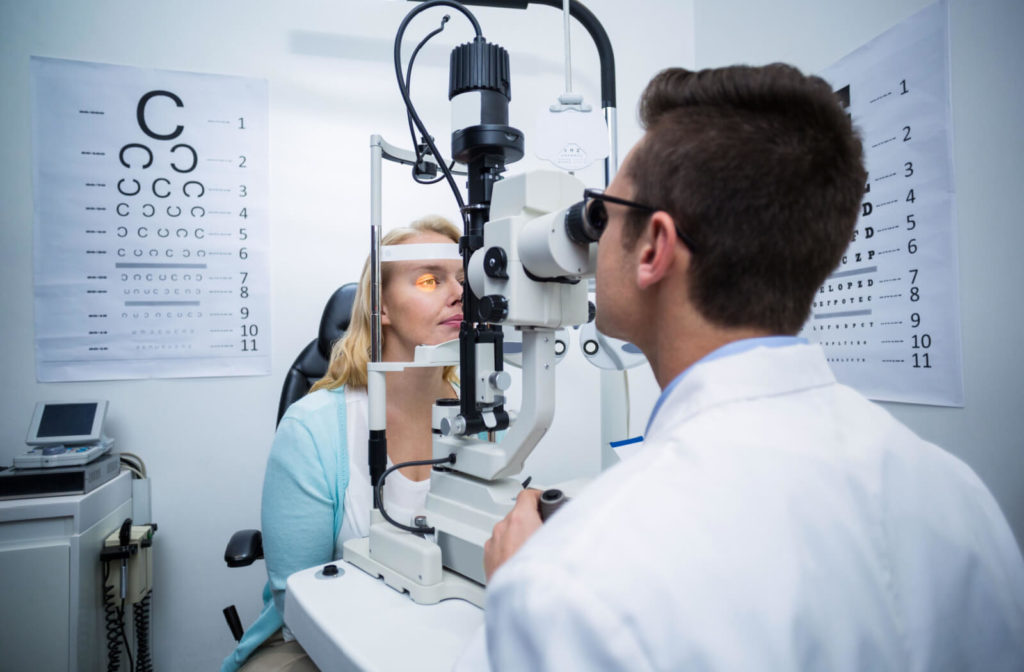Glaucoma is commonly an age-related eye problem, although it can affect people at any age. One significant concern with glaucoma is that it often begins developing with little to no symptoms. While this is often the case, there are some possible signs of glaucoma, depending on the type.
5 early signs of glaucoma may include:
- Vision loss or blurry vision
- Eye pain
- Halos around lights
- Red eyes
- Nausea or vomiting
Knowing the signs of glaucoma is important, but not more important than regular eye exams. Your optometrist may be able to detect signs of glaucoma during an exam, even if you aren’t experiencing anything noticeable yet. While many types of glaucoma are slow-progressing, certain types, like angle-closure or acute glaucoma, could require emergency care.
What Is Glaucoma?
Glaucoma is a group of eye conditions characterized by damage to the optic nerve, which can lead to vision loss or blindness if left untreated. It’s typically associated with increased pressure in the eye.
There are different types of glaucoma, the following typically being the most common:
- Open-angle glaucoma: In this type, the drainage angle of the eye becomes less efficient over time, leading to a gradual increase in eye pressure. Open-angle glaucoma often develops slowly and without noticeable symptoms until advanced stages. This is the most common type, accounting for 90% of all glaucoma cases.
- Angle-closure glaucoma: This occurs when the iris bulges forward, blocking the drainage angle of the eye. Acute angle-closure glaucoma can develop suddenly and is considered a medical emergency requiring immediate attention. Angle-closure glaucoma is sometimes called narrow-angle glaucoma.
- Normal-tension glaucoma: Also known as low-tension or normal-pressure glaucoma, this type occurs when damage to the optic nerve happens despite normal eye pressure. The exact cause is not fully understood, but it may be related to poor blood flow to the optic nerve.
- Secondary glaucoma: This type of glaucoma is a result of another underlying condition, such as inflammation, trauma, or certain medications. The increased eye pressure occurs as a secondary effect of the primary condition.
It’s important to note that glaucoma is a progressive disease, and early detection, regular eye exams, and appropriate treatment are essential in managing the condition and preserving vision.
5 Early Signs of Glaucoma
A significant and concerning factor with glaucoma is that it often presents with very few symptoms early in its development. Part of the reason for this is that changes can happen gradually and be difficult to notice. Some warning signs of glaucoma may be noticeable, however, ranging from altered vision to nausea.
Vision Loss or Blurry Vision
One of the earliest signs of glaucoma is loss of vision or blurry vision. Glaucoma damages the optic nerve, which is responsible for carrying visual information from the eye to the brain. This can result in a gradual loss of vision, especially peripheral vision. If you notice a blurring or disappearance of objects in your side vision, it’s essential to seek medical attention from your eye doctor.
Eye Pain
Glaucoma can cause painful and uncomfortable sensations in the eyes. Some people may experience headaches, eye aches, or pain around the eyes. If you have been experiencing any discomfort around your eyes, especially if accompanied by other symptoms of glaucoma, you should seek medical attention.
Halos Around Lights
Halos are a common symptom of glaucoma that occur when the cornea becomes swollen due to increased fluid buildup in the eye. This can cause the cornea to become more reflective, leading to a halo-like appearance around lights. If you notice halos around lights, especially at night, it’s a good idea to see your optometrist.
Red Eyes
Red or bloodshot eyes can be a sign of many eye conditions, including glaucoma. Red eyes can be caused by increased pressure in the eye, which can lead to blood vessel damage. While redness can mean a variety of things and may resolve on its own, it’s crucial to identify the source, especially if the redness persists. If you notice eye redness accompanied by other glaucoma symptoms, you should consult an eye doctor.
Nausea & Vomiting
One may not immediately associate any kind of stomach upset with an eye-related condition like glaucoma. However, research indicates that there can be a link between glaucoma, specifically acute glaucoma, and nausea and abdominal discomfort. Stomach upset in itself isn’t a guarantee that you have glaucoma. But it’s important information to tell your eye doctor if it’s happening in conjunction with any other symptoms discussed above.

Discuss Glaucoma Symptoms with Your Optometrist
Glaucoma is a severe eye condition that can affect anyone, but seniors may be at a higher risk. Since glaucoma often doesn’t show early signs, regular, comprehensive eye exams are crucial to protect your eye health.
The American Optometric Association recommends that most people receive a comprehensive eye exam every 1 to 2 years, depending on age and overall eye health.
Contact us to book an appointment at Seal Beach Eyes if you have any of these glaucoma symptoms or it’s time for your next exam.




